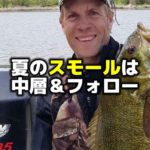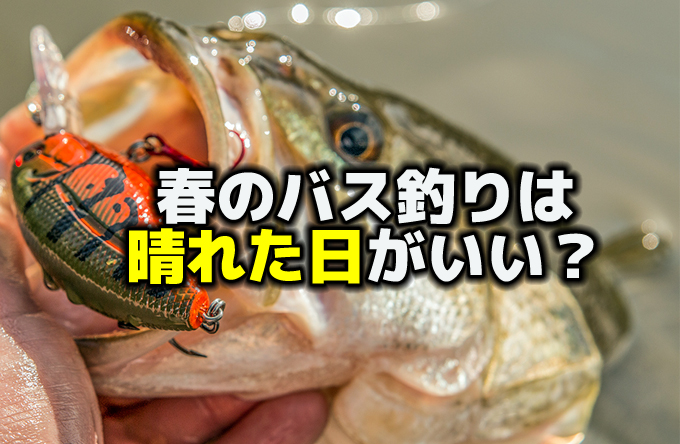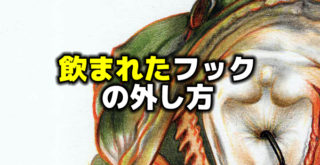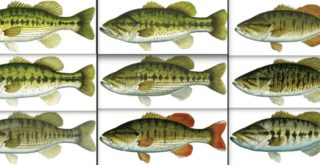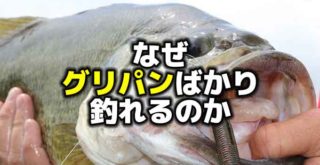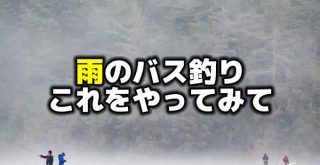夏のバス釣り:夏バスを見つける10のポイント

Photo by WORLD FISHING NETWORK
こんにちは!店長の小山です!
本日は海外サイトより、”Top 10 Places to Find Summer Bass”という記事を引用してご紹介いたします。
引用先:worldfishingnetwork.com”Top 10 Places to Find Summer Bass”By: Keith 'Catfish’ Sutton(海外サイトです)
夏のバスというのは、場所や時期にもよるかと思いますが、年間を通してみると活性の高い状態にあります。
いえ、正確に言うとちょっと違いまして、活性が高いといいますか、水温が上がると代謝が良くなりすぎてしまい、短期間でバスの体型がガリガリになってしまいます。このままだと飢え死にしてしまうので、食わなきゃヤバい、というのが夏バスの状態というのが正しい表現なのでしょうか。
ですので、高水温によってグロッキー状態になりつつも、冬に比べたらはるかに食い気がある状態ではあります。
そのため、こう言ってしまうのもなんですが、運が良ければ適当にやっていても釣れてしまうこともあるんですよね。
しかし、このブログをご覧いただいている皆さんが、運で釣って満足されるはずがありません(笑)。ましてやそんな運など持ってないとおっしゃる方も多いかもしれません(失礼ですみません)。
やはりバスを釣るのであれば狙って釣りたい、バスを探し出して釣りたいという気持ちは私も非常に深く共感させていただきます。
この記事は、北アメリカを中心としたフィッシング専門メディア「WORLD FISHING NETWORK」のもので、夏のバスを探すならここ、というのが10個、書かれています。
良い場所と悪い場所があるというのなら、もちろん良い場所で釣りたいですよね。
それでは早速その10個を読んでいきましょう。
1:サーモクライン
During summer, many lakes stratify into three layers: cold, poorly oxygenated water on bottom; warm, moderately oxygenated water on top; and a layer of cool, oxygen-rich water called the thermocline in the middle. Summer bass stay in or near the thermocline where oxygen levels and water temperature are optimal.
The thermocline’s depth and thickness vary from lake to lake. To find it, watch the sonar on your boat for suspended fish—any fish. Most will be within a specific stratum of water. That’s the thermocline. When fishing, start at that depth, and stay at that depth unless all else fails.
夏には、多くの湖で水中が3つの層に分けられます。 暖かく、適度に酸素を含んだ水が上部にあり、真ん中にはサーモクラインと呼ばれる、涼しくて酸素が多い水の層があります。 夏のバスは、酸素濃度と水温が最適であるサーモクライン内またはその近くに留まります。
サーモクラインの深さと厚さは湖によって異なります。 それを見つけるには、ボートの魚探を見て多くの魚の中のサスペンドしている魚を見てください。 大部分は特定の層の範囲にいます。 そこがサーモクラインです。 釣りをするときは、その深さから始め、何をやってもダメという状況にならない限り、そのレンジにとどまってください。
2:シャローレッジ&チャンネルブレイク
Watch for shallow ledges and channel breaks, too. These aren’t deep drop-offs into major river or creek channels, but rather shallow ditches, cuts and ledges in coves or near bluffs. The best structures are associated with nearby weedbeds, timber stands or other bass cover.
Jigs and big soft-plastic crayfish are ideal for fishing these structures. Cast from your boat to work them down drop-offs, hopping them stair-step fashion.
シャローにあるレッジ(段差)とチャンネルブレイクも見てください。 これらはメインリバーやクリークチャンネルに向かって落ちるブレイクではなく、シャローにある溝や細長いワンド、小さなワンドや崖の近くにある水中の段差のことを指しています。 最も良い地形変化は、近くにウィードベッドや立木、その他バスが好きなカバーが絡んでいるものです。
ジグと大きなクロー系ワームの組み合わせは、これらの地形変化を釣るのに理想的です。 ボートからキャストしてドロップオフをダウンヒルで探り、カケアガリを階段を上るように探ってください。
3:桟橋&ウッドデッキ
Summer bass may move shallow, even on sunny days, if they can find shade. Boat docks and fishing piers provide this and may produce bass throughout the day.
Savvy anglers often position their boat close and use a short spinning or spincasting outfit to shoot a jig or plastic worm into tight areas underneath. Prepare for a hit as the lure falls, but if nothing strikes, a slow retrieve near bottom frequently produces.
夏のバスは晴れた日であっても、日陰を求めてシャローをうろつきます。 桟橋や橋脚はこれを提供し、一日を通してバスの付き場になっていることがあります。
ベテランアングラーはよくボートを近くに付け、ジグやワームを下にタイトに入れていくむために、短めのスピニングかスピンキャストタックルを使っています。 ルアーのフォール中のバイトに備えますが、何も当たらなければ、ボトム近くをスローリトリーブすることでよくバイトが発生します。
4:ウィードベッド
Green aquatic vegetation attracts baitfish, frogs, crayfish and other bass forage. Bass follow. Summer anglers should, too.
Bass prefer parcels of cover and structure that interrupt the continuity of a weedbed. In other words, look for something different to fish—an isolated log or stump surrounded by vegetation, a point of weeds, an inner pocket of open water or another distinguishing feature.
Soft-plastic rats or frogs cast with spinning tackle are good lures here. Position your boat near the weed line and throw to openings, allowing the lure to sit a while before retrieving it with short jerks. If the lure is weedless, cast it on top of plants, then pull it off and swim it slowly between them.
緑の水生植物は、ベイトフィッシュ、カエル、ザリガニ、その他バスの食料となるものを集めます。 バスもそれに続きます。夏のアングラーもそれに続くべきです。
バスは、ウィードベッドを途中で途切れさせるようなカバーや地形変化を好みます。 言い換えれば魚ではない他のもの、単独の丸太やウィードの中にあるスタンプ、ウィードの岬、オープンウォーターの水中ワンド、その他の特徴などといったものを探してください。
ここではソフトプラスチックのネズミ系ルアーやフロッグをスピニングタックルでキャストします。 ボートをウィードライン(ウィードエッジ)の近くに配置し、ウィードの間に投げて、ルアーをしばらく置いてから短いジャークでそれを回収するようにします。 ウィードレスルアーであれば、ウィードの上にキャストして引っぱってくるか、ウィードの間をゆっくりと泳がせます。
5:漁礁
Fisheries agencies often sink reefs of trees to make fish attractors. Those in deeper water hold bass throughout summer and are easily found by locating marker buoys or attractor signs.
Use your boat’s sonar to determine boundaries of an attractor, then cast to the edge using a sinking lure such as a lipless crankbait or jig. Count the lure down until you get a hit or hit brush. If you get a hit, use the same count next cast. If you hit brush, use a shorter count. You’ll quickly determine a pattern that nabs bass.
漁協などによって魚の付き場を作るために漁礁を沈めていることがあります。 ディープに設置されたものは夏の間中バスの付き場となり、マーカーブイや漁礁という目印(杭など)を見つけることによって簡単に見つけることができます。
魚探を使用して漁礁のエッジを探し出し、次にバイブレーションやジグなどのシンキングルアーを使用してエッジにキャストします。 バスがヒットするか漁礁にヒットするまでルアーをカウントダウンしてください。 ヒットしたら、次のキャストも同じカウントを使用します。 オダを撃つような場合は、少し短めのカウントで使用してください。 バスがヒットする傾向を素早く掴むことが重要です。
6:流れ込みの最上流
Fishing backs of tributary creeks is another fruitful summer tactic. Bass like these areas because of cooler temperatures, higher oxygen levels and good food supplies. Spring-fed creeks are especially productive.
Look for tributaries with steady current and plentiful woody cover. Motor your boat upstream, then fish your way out, casting a Texas-rigged plastic worm or other weedless lure around cover in the creek channel and along both banks.
主要な流れ込みをさかのぼった最上流での釣りはまた、有効な夏の戦術です。 低水温でより高い酸素レベル、絶え間ない食糧供給があるため、バスはこれらのエリアを好みます。 湧き水のあるクリークは特に有効です。
安定した流れと豊富なウッドカバーのある支流を探します。 ボートを上流に向かって走らせ、ワームのテキサスリグやその他のウィードレスルアーをクリークチャンネル付近のカバーや両岸に沿って釣り上がってください。
7:橋脚と付近のリップラップ
Summer bass also orient to bridge pilings and deep riprap. These structures offer a combination of hot-weather drawing cards, including current, depth, forage and cover. Bass may be suspended near pilings, on shoreline riprap or along the channel beneath the bridge.
While watching your sonar, ease your boat along pilings and note the depth of fish concentrations. Then back away and cast beyond the pilings, allowing your lure to fall to the correct depth before beginning a slow retrieve. Keep the lure close to pilings or rocks, bumping them occasionally. A plastic frog or rat hopping off the riprap into adjacent water may draw smashing strikes, too.
夏のバスはまた、橋脚やディープのリップラップについています。 これらのストラクチャーは、流れ、水深、ベイト、カバーなどが組み合わさる高水温期の好スポットとなります。 バスは橋脚の近く、ショアラインのリップラップ、または橋の下のチャンネル沿いにサスペンドすることがあります。
魚探を見ながら、アイドリングでボートを橋脚のそばを通し、魚のいるレンジに注意してください。 その後、離れたら橋脚を越えてキャストして、ルアーをスローリトリーブする前に正しい深さまでフォールさせます。 極力ルアーを杭や岩に近づけ、ときには当てていきます。 ワーム素材のフロッグやネズミも、リップラップ際の水面でホッピングすると激しいバイトを得ることがあります。
8:スタンプ地帯
Near dawn and dusk, you may find summer bass in stump fields on deep flats near bottom channels. These fish often scatter, but by fan-casting plastics or crankbaits from an anchored boat, you’ll often catch loads of nice largemouths.
When you catch one fish, cast immediately to the same spot, repeating until you no longer catch fish. If you don’t find a bass again quickly, move. A common mistake is staying in one place too long.
夜明けや夕暮れ近くは、チャンネル付近のディープフラットにあるスタンプ地帯で夏のバスが見つかるかもしれません。 これらのバスは散っていますが、ボートをアンカー固定しワームやクランクを扇型に広くキャストしていくことで、素晴らしいラージマウスが釣れます。
1匹の魚をキャッチしたらすぐに同じ場所にキャストし、魚が釣れなくなるまで繰り返します。 もうバスが釣れなくなったと思ったら、移動してください。 よくやりがちなミスは、あまりにも長い間1つの場所に留まることです。
9:もとの池・湖
Small ponds and lakes inundated when larger lakes fill are prime locales for hot-weather largemouths. These offer easy access to deep-water holding areas and shallow feeding spots. They’re especially productive in large shallow lakes.
Pinpoint the spot with your boat’s sonar, then look within it for points, drop-offs or humps that may attract bass. If scattered trees or stumps exist around the perimeter, fish them carefully.
小さな池や湖があふれて大きな湖になったようなフィールドでは、元の池や湖の部分は暑い時期のラージマウスのための主要な場所になります。 これは、ディープの付き場からフィーディング場となるシャローとの容易なアクセスが可能になります。 これらは特に大きくて浅い湖で有効になります。
魚探を使ってその地点を特定し、その中での岬、ドロップオフ、ハンプなどバスを引き寄せるようなものを探します。 その周辺にスタンプや立木が散らばっている場合は、注意深く釣り上げてください。
10:サイプレスツリー
Bald cypresses attract bass wherever they are found. Largemouths won’t be around the same trees year-round, however. In summer, action is best around cypresses in or near the deepest water, trees you’ll need a boat to fish.
Narrow your fishing areas to particular types of trees. Cypresses standing alone or in small clusters offshore often indicate the presence of an underwater hump and always are worth trying. Trees with big open hollows also should be checked as lunker largemouths hide in dark interiors to ambush prey. Also focus on the outermost cypress trees on points and trees with lots of visible knees some distance from the buttressed trunk.
どこであっても、サイプレスはバスを引き寄せます。しかし、ラージマウスバスは1年中同じ木の周りにはないでしょう。夏には、最もディープに近いサイプレスツリーの周りが最高の拠点となります。サイプレスツリーを釣るにはボートが必要になります。
釣り場は特定の種類の木に絞ってください。単独または沖合での小さな集まりのサイプレスは、しばしば水中にあるハンプの存在を示し、試す価値があります。巨大な空洞のある木は、暗い室内に大型のラージマウスが隠れ、獲物を待ち伏せしているため、チェックする必要があります。また、最も外側のサイプレスツリーに焦点を当てると、木と並んで少し離れて目に見える呼吸根がたくさんあります。
※呼吸根【こきゅうこん】…水中に生える木などに見られる、呼吸のために水面に向かって伸びる特殊な根。
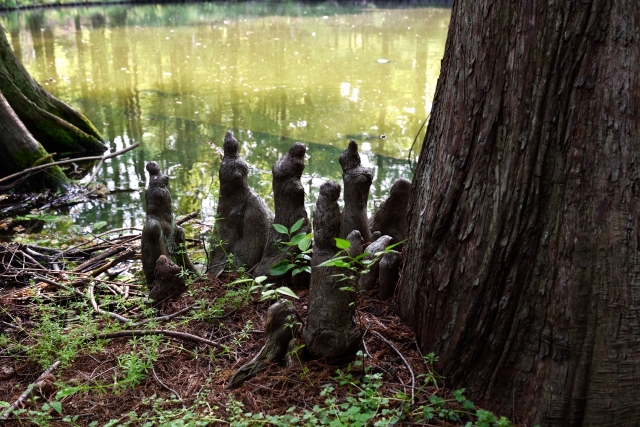
呼吸根の一例
いかがでしたか。
ある方にとっては、夏のポイントはまだまだいっぱいあるよとおっしゃるかもしれません。
確かに、その通りでしょう。ここに挙げられた10個のポイントが大事ということではなく、あくまでも、夏には夏のバスの付き場があるよということを覚えておくことが大事なんですよね。
いくらいいタックルやルアーを揃えても、バスがいないところに投げ続けてしまっては意味がありませんからね。
こういったヒントを皮切りに、自分独自の夏のバスの付き場を探し出すことに意味があると思いますし、もちろん、この記事に書かれている通りに狙ってみれば、バスのいる確率は高いでしょうから、そうして楽しむのも良いと思います。
知らなかった事実が出てきたら、どんどん試してみるのがいいと思います。
また、⑧のスタンプ地帯についてですが、日本ではスタンプといいますと木の根元付近を輪切りにされた切り株のことをイメージしませんでしょうか。
それもスタンプなのですが、アメリカでは、根元付近だけではなく、木が途中で折れているようなものもスタンプと呼んでいるようです。根元で切れていても、日本では立木と呼ぶような長さが3メートルあるようなものでも、途中で切れていればそれはスタンプと呼ぶようですので、やや混乱してしまいますが、そのような認識で⑧の項目を読んでいただければと思います。
バスはいつだって、自分にとって快適なところにいるようです。
この夏、バスの気持ちになって、快適なところを意識して釣りをしてみたいなと思います。
それでは、また。
毎度ありがとうございます!








